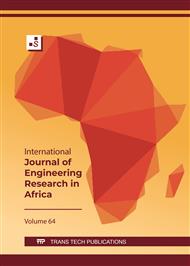[1]
G. Aklilu, S. Adali, and G. Bright, "Experimental characterization of hybrid and non-hybrid polymer composites at elevated temperatures, Int. J. Eng. Res. Africa, 36 (2018) 37–52.
DOI: 10.4028/www.scientific.net/jera.36.37
Google Scholar
[2]
M. Herráez, N. Pichler, G. A. Pappas, C. Blondeau, and J. Botsis, Experiments and numerical modelling on angle-ply laminates under remote mode II loading, Compos. Part A Appl. Sci. Manuf., 134 (2020)105886.
DOI: 10.1016/j.compositesa.2020.105886
Google Scholar
[3]
S. S. Rahimian Koloor, A. Karimzadeh, N. Yidris, M. Petrů, M. R. Ayatollahi, and M. N. Tamin, An energy-based concept for yielding of multidirectional FRP composite structures using a mesoscale lamina damage model, Polymers (Basel)., 12, 1 (2020) 157.
DOI: 10.3390/polym12010157
Google Scholar
[4]
R. CZARNEK, D. POST, and C. HERAKOVICH, Edge Effects in Composites by Moiré Interferometry, Exp. Tech., 7, 1 (1983) 18–21.
DOI: 10.1111/j.1747-1567.1983.tb01664.x
Google Scholar
[5]
C. T. Herakovich, D. Post, M. B. Buczek, and R. Czarnek, Free Edge Strain Concentrations in Real Composite Laminates: Experimental-Theoretical Correlation, J. Appl. Mech., 52, 4 (1985) 787–793.
DOI: 10.1115/1.3169147
Google Scholar
[6]
C. T. Herakovich, Edge effects and delamination failures, J. Strain Anal. Eng. Des., 24, 4 (1989) 245–252.
Google Scholar
[7]
J. Echaabi, F. Trochu, X. T. Pham, and M. Ouellet, Theoretical and Experimental Investigation of Failure and Damage Progression of Graphite-Epoxy Composites in Flexural Bending Test, J. Reinf. Plast. Compos., 15, 7 (1996) 740–755.
DOI: 10.1177/073168449601500707
Google Scholar
[8]
Y. Benbouras, M. Bellahkim, A. Maziri, E. Mallil, and J. Echaabi, An analytical and experimental study of the nonlinear behaviour of a carbon/epoxy under a three-point bending test, Plast. Rubber Compos., 51, 3 (2022) 145-153.
DOI: 10.1080/14658011.2021.1950457
Google Scholar
[9]
Y. Benbouras, M. Bellahkim, A. Maziri, E. Mallil, and J. Echaabi, Nonlinear modeling of the failure of a graphite epoxy under a three-point bending test:, Polym. Polym. Compos., 28, 2 (2019) 119–139.
DOI: 10.1177/0967391119866597
Google Scholar
[10]
M. Bellahkim, Y. Benbouras, A. Maziri, E. Mallil, and J. Echaabi, The Effect of Boundary Conditions and Stacking Sequence on the Nonlinear Behavior of Laminated Composite Plates in Bending, Int. J. Eng. Res. Africa, 57 (2021) 33–47.
DOI: 10.4028/www.scientific.net/jera.57.33
Google Scholar
[11]
C. T. Herakovich, Influence of layer thickness on the strength of angle-ply laminates, J. Compos. Mater.,16, 3(1982) 216–227.
DOI: 10.1177/002199838201600305
Google Scholar
[12]
C. T. Herakovich, On the Relationship between Engineering Properties and Delamination of Composite Materials, J. Compos. Mater.,15, 4 (1981) 336–348.
DOI: 10.1177/002199838101500404
Google Scholar
[13]
C. T. Herakovich, Failure modes and damage accumulation in laminated composites with free edges, Compos. Sci. Technol., 36, 2(1989) 105–119.
DOI: 10.1016/0266-3538(89)90082-1
Google Scholar
[14]
A. Diaz Diaz and J. F. Caron, Interface plasticity and delamination onset prediction, Mech. Mater., 38, 7 (2006) 648–663.
DOI: 10.1016/j.mechmat.2005.12.001
Google Scholar
[15]
N. R. J. Hynes et al., Effect of stacking sequence of fibre metal laminates with carbon fibre reinforced composites on mechanical attributes: Numerical simulations and experimental validation, Compos. Sci. Technol., 221 (2022) 109303.
DOI: 10.1016/j.compscitech.2022.109303
Google Scholar
[16]
S. C. Das et al., Effect of stacking sequence on the performance of hybrid natural/synthetic fiber reinforced polymer composite laminates, Compos. Struct., 276 (2021) 114525.
DOI: 10.1016/j.compstruct.2021.114525
Google Scholar
[17]
F. Pinto, L. Boccarusso, D. De Fazio, S. Cuomo, M. Durante, and M. Meo, Carbon/hemp bio-hybrid composites: Effects of the stacking sequence on flexural, damping and impact properties, Compos. Struct., 242, (2020) 112148.
DOI: 10.1016/j.compstruct.2020.112148
Google Scholar
[18]
Y. Yuan, X. Yao, B. Liu, H. Yang, and H. Imtiaz, Failure modes and strength prediction of thin ply CFRP angle-ply laminates, Compos. Struct., 176 (2017) 729–735.
DOI: 10.1016/j.compstruct.2017.06.005
Google Scholar
[19]
M. A. Caminero, G. P. Rodríguez, and V. Muñoz, Effect of stacking sequence on Charpy impact and flexural damage behavior of composite laminates, Compos. Struct., 136 (2016) 345-357.
DOI: 10.1016/j.compstruct.2015.10.019
Google Scholar
[20]
ASTM D790, Standard Test Methods for Flexural Properties of Unreinforced and Reinforced Plastics and Electrical Insulating Materials, Am. Soc. Test. Mater., 1997.
DOI: 10.1520/d0790-10
Google Scholar
[21]
Berthelot, J. M., & Ling, F. F., Composite Materials. Mechanical behaviour and structural analysis, Springer, New York, 1999.
Google Scholar
[22]
F. Mujika, On the effect of shear and local deformation in three-point bending tests, Polym. Test., 26, 7 (2007) 869–877.
DOI: 10.1016/j.polymertesting.2007.06.002
Google Scholar
[23]
G. Caprino, P. Iaccarino, and A. Lamboglia, The effect of shear on the rigidity in three-point bending of unidirectional CFRP laminates made of T800H/3900-2, Compos. Struct., 88, 3 (2009) 360–366.
DOI: 10.1016/j.compstruct.2008.04.014
Google Scholar
[24]
J. D. Fuller and M. R. Wisnom, Pseudo-ductility and damage suppression in thin ply CFRP angle-ply laminates, Compos. Part A Appl. Sci. Manuf., 69 (2015) 64–71.
DOI: 10.1016/j.compositesa.2014.11.004
Google Scholar
[25]
M. Jalalvand, G. Czél, and M. R. Wisnom, Damage analysis of pseudo-ductile thin-ply UD hybrid composites - A new analytical method, Compos. Part A Appl. Sci. Manuf., 69 (2015) 83–93.
DOI: 10.1016/j.compositesa.2014.11.006
Google Scholar
[26]
B. W. SMITH, Fractography for continuous fiber composites: Engineered materials handbook, Compos. Ohio, USA ASM Int., 1 (1993) 786–793.
Google Scholar
[27]
M. C. S. Moreno and S. H. Muñoz, Pseudo-ductile effects in±45∘ angle-ply CFRP laminates under uniaxial loading: Compression and cyclic tensile test, Compos. Part B Eng., 233 (2022) 109631.
DOI: 10.1016/j.compositesb.2022.109631
Google Scholar


